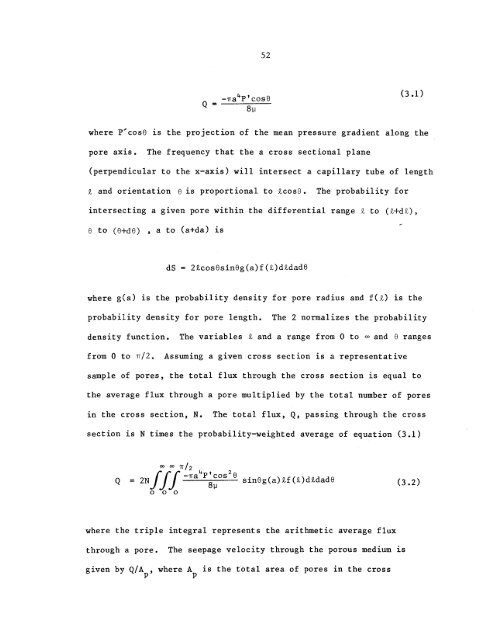longitudinal dispersion in nonuniform isotropic porous media
longitudinal dispersion in nonuniform isotropic porous media
longitudinal dispersion in nonuniform isotropic porous media
You also want an ePaper? Increase the reach of your titles
YUMPU automatically turns print PDFs into web optimized ePapers that Google loves.
Q =<br />
52<br />
(3.1)<br />
where P'cos8 is the projection of the mean pressure gradient along the<br />
pore aX1S. The frequency that the a cross sectional plane<br />
(perpendicular to the x-axis) will <strong>in</strong>tersect a capillary tube of length<br />
£ and orientation S is proportional to £cosS. The probability for<br />
<strong>in</strong>tersect<strong>in</strong>g a given pore with<strong>in</strong> the differential range £ to (£+d£),<br />
S to (S+dS) , a to (a+da) 1S<br />
dS 2£cosSs<strong>in</strong>Sg(a)f(£)d£dad8<br />
where g(a) is the probability density for pore radius and f(£) is the<br />
probability density for pore length. The 2 normalizes the probability<br />
density function. The variables £ and a range from 0 to 00 and S ranges<br />
from 0 to n/2. Assum<strong>in</strong>g a given cross section is a representative<br />
sample of pores, the total flux through the cross section is equal to<br />
the average flux through a pore multiplied by the total number of pores<br />
<strong>in</strong> the cross section, N. The total flux, Q, pass<strong>in</strong>g through the cross<br />
section is N times the probability-weighted average of equation (3.1)<br />
where the triple <strong>in</strong>tegral represents the arithmetic average flux<br />
through a pore. The seepage velocity through the <strong>porous</strong> medium is<br />
given by Q/A , where A 1S the total area of pores <strong>in</strong> the cross<br />
p p<br />
(3.2)

















